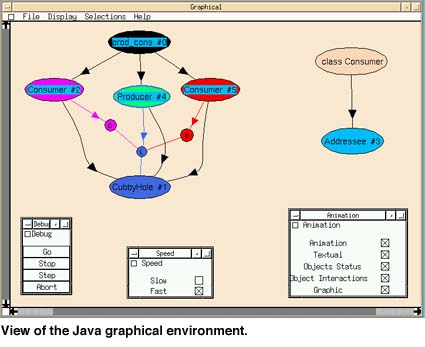
ERCIM News No.36 - January 1999

![]()
ERCIM News No.36 - January 1999
A Formal Semantics and an Interactive Environment for Java
by Isabelle Attali
Being both object-oriented and concurrent, the Java model features interrelated aspects that are critical for the understanding of an application: objects, static variables, threads, locks, etc. We want to know how to visualize the various entities that participate in the execution of a Java program.
These concepts are not easy to understand and to handle for a programmer, nor easy to formally describe from a designer point of view.
We address these questions using a formal description of the syntax and the semantics of the Java language (useful for language designers and implementers), and as well as an interactive development environment (useful for programmers). We are using a powerful generic interactive environment named Centaur (http://www.inria.fr/croap/centaur/centaur.html). Centaur produces a programming environment, dedicated to a given language, from a formal description of the language.
This research started in spring 1997 with Denis Caromel (Professor at University Nice - INRIA Sophia Antipolis - CNRS) and Marjorie Russo, PhD Student), and is pursued at INRIA Sophia Antipolis.
The topology of instance variables within an object-oriented system can be rather complex. Are they mainly trees? Are there DAGs? Are there cycles, and where? Those are important questions for understanding an application. How can a programming environment provide that information to programmers in a simple and effective manner, without requiring them to compare reference values within a text-only debugger? Static variables raise special concerns, as they can be accessed from objects without an explicit reference to them.
When it comes to multi-threading and concurrent accesses, that information becomes even more crucial. How can we effectively visualize the objects shared by a given thread? Are there any recursive calls, either directly or through cycles? Do several threads access a single object at the same time?
We provide solutions to those problems and demonstrate them in an interactive and graphical environment (shown in following Figure and also at http://www.inria.fr/croap/java). It allows us to visualize objects and thread activities at execution in both a textual and a graphical manner, eg, the topology of the object graph (trees, DAGs, cycles), thread activities and status, locks, and synchronizations. Synthetic views give relevant information on status of objects and interaction between objects and threads.
Using the Centaur system, this graphical environment is derived from an executable operational semantics of Java: execution a Java program is, in fact, an interpretation of the semantics with the program source as data (there is no byte-code, and no virtual machine is required). Animation of the various views is performed by messages from the semantics interpreter to the visualization engines (textual and graphical) in order to show, during execution, the changes in the structures. No instrumentation is required from the programmer.
We do not want to compete with commercial systems for Java development. Instead, we propose two main concepts which can then be exploited within any Java environment:
- graphical visualization of the object graph topology
- interactive symbolic debugging (no (re-)compilation is necessary).
Future activities include the following directions:
- allow user-control of the interleaving between all threads
- gain in scalability, with an abstract view of the object graph
- benefit from the formal definition the ability to perform formal verification of Java programs.

Related Projects
With Denis Caromel and Carine Courbis (PhD Student), we recently started a related research project. Our goal is to facilitate smart card programming using Java Card, a Java subset that deals with limited resources (http://www.inria.fr/croap/javacard).
Finally, with Denis Caromel and Romain Guider (PhD Student), we are also investigating the use of static analysis, based on abstract interpretation, for distributed and parallel programming in Java. For this work, we utilize the product of another related research project: the ProActive PDC Java Library (formerly Java//, Java Parallel), a Java library for seamless sequential, multithreaded and distributed programming using Java (http://www.inria.fr/sloop/javall). See also http://www.inria.fr/croap/java.Please contact:
Isabelle Attali - INRIA
Tel: +33 4 92 38 79 10
E-mail: Isabelle.Attali@sophia.inria.fr